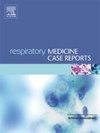Clinical characteristics and outcomes in patients with Anti-MDA5 positive interstitial lung disease: A case series from a lung transplant center
IF 0.7
Q4 RESPIRATORY SYSTEM
引用次数: 0
Abstract
Background
Anti-Melanoma Differentiation-5 (MDA5)-positive dermatomyositis (DM) is a rare autoimmune disorder frequently complicated by rapidly progressive interstitial lung disease (RP-ILD), often with poor outcomes. Data from European tertiary care and transplant centers remain limited.
Objective
To describe the clinical presentation, treatment course, and outcomes of five patients with anti-MDA5+DM-associated ILD at a lung transplant center.
Methods
We retrospectively reviewed five patients with confirmed anti-MDA5 seropositivity and interstitial lung involvement between 2023 and 2025. Demographic data, clinical features, lung function, imaging, antibody levels, immunosuppressive treatment, and outcomes were analyzed.
Results
Of the five patients 3 were female and two were male with a median age of 51 years (range 22–69). Clinical severity varied from mild cutaneous and pulmonary disease to fulminant RP-ILD. One patient required extracorporeal membrane oxygenation (ECMO) and eventually underwent lung transplantation. Treatment strategies included high-dose corticosteroids, rituximab, mycophenolate mofetil, tacrolimus, and intravenous immunoglobulins (IVIG). Patients with early initiation of rituximab or IVIG and declining anti-MDA5 antibody titers generally showed pulmonary stabilization. Serial lung function tests correlated with clinical improvement or deterioration. Cutaneous flare-ups persisted in some patients despite pulmonary stability.
Conclusion
This case series underscores the heterogeneous trajectory of anti-MDA5+DM-ILD and highlights the importance of timely diagnosis, aggressive immunosuppressive treatment, and early transplant evaluation in severe cases. Serial monitoring of anti-MDA5 antibody titers and lung function testing may help guide therapeutic decisions and prognostication.
抗mda5阳性间质性肺病患者的临床特征和预后:来自肺移植中心的病例系列
抗黑色素瘤分化-5 (MDA5)阳性皮肌炎(DM)是一种罕见的自身免疫性疾病,常并发快速进展性间质性肺疾病(RP-ILD),通常预后较差。来自欧洲三级保健和移植中心的数据仍然有限。目的描述某肺移植中心5例抗mda5 + dm相关ILD患者的临床表现、治疗过程和预后。方法回顾性分析2023年至2025年间5例确诊抗mda5血清阳性且肺间质性受累的患者。分析了人口统计资料、临床特征、肺功能、影像学、抗体水平、免疫抑制治疗和结果。结果5例患者中女性3例,男性2例,中位年龄51岁(22 ~ 69岁)。临床严重程度从轻度皮肤和肺部疾病到暴发性RP-ILD不等。1例患者需要体外膜氧合(ECMO),最终接受肺移植。治疗策略包括大剂量皮质类固醇、利妥昔单抗、霉酚酸酯、他克莫司和静脉注射免疫球蛋白。早期开始使用利妥昔单抗或IVIG且抗mda5抗体滴度下降的患者通常表现为肺稳定。连续肺功能检查与临床改善或恶化相关。尽管肺稳定,一些患者的皮肤症状仍持续发作。结论该病例系列强调了抗mda5 +DM-ILD的异质性轨迹,并强调了及时诊断,积极免疫抑制治疗和严重病例早期移植评估的重要性。连续监测抗mda5抗体滴度和肺功能测试可能有助于指导治疗决策和预后。
本文章由计算机程序翻译,如有差异,请以英文原文为准。
求助全文
约1分钟内获得全文
求助全文
来源期刊

Respiratory Medicine Case Reports
RESPIRATORY SYSTEM-
CiteScore
2.10
自引率
0.00%
发文量
213
审稿时长
87 days
 求助内容:
求助内容: 应助结果提醒方式:
应助结果提醒方式:


